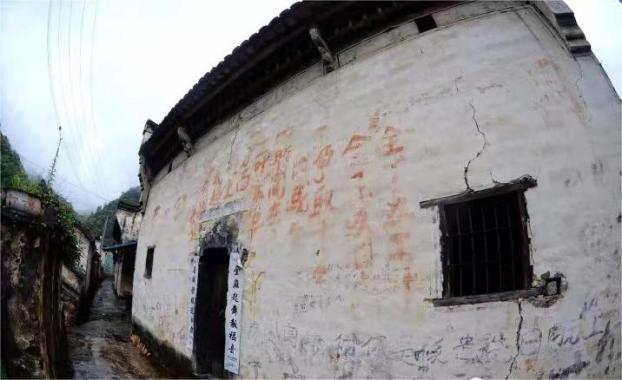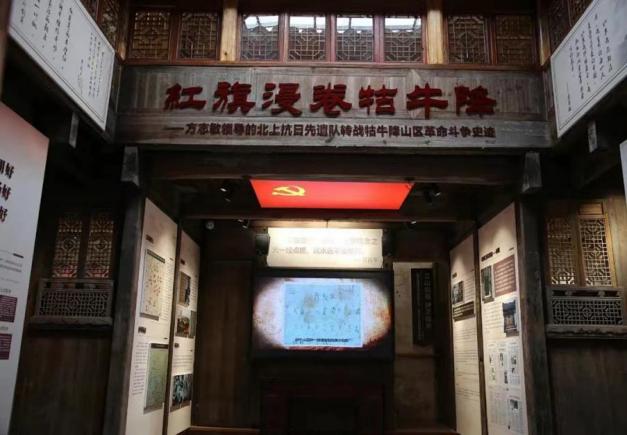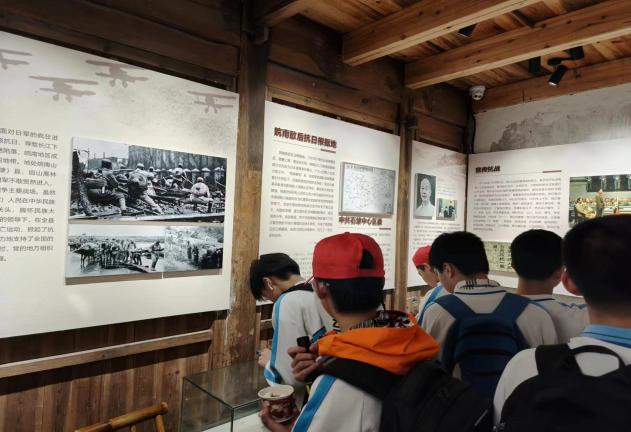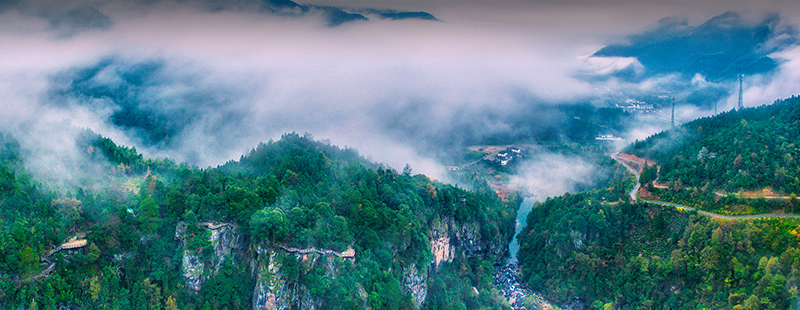Red culture
Release Date:2024-06-25 Source: Number of views:201
Red culture
A wall with slogans reflects the historical vicissitudes of more than half a century in China.


Introduce the history of the Red Army setting up an arsenal here to forge weapons during the period of the New Democratic Revolution and the history of their marching northward to resist Japanese aggression. Explain that dozens of people successively joined various anti-Japanese organizations to cover and assist the anti-Japanese troops. After liberation, seven people were posthumously recognized as martyrs by the Ministry of Civil Affairs of the People's Republic of China. The slogans on the red slogan wall were not written with ink. Instead, black stones picked up from the river were smashed on the ground, ground into fine pieces, mixed together, and then written with simple writing brushes made of indocalamus leaves.
The slogan "Eliminate the Baojia System and Defeat the Nationalist Bandit Party" was written by a political organization affiliated with the "Revolutionary Base Area in Northeast Jiangxi" led by Fang Zhimin, with the inscription "Political Propaganda of the Red Army" at the end. The slogan "The vanguard detachment for resisting Japanese aggression in the north is the savior of your difficulties during the Spring Festival. The only way to break through the difficulties during the Spring Festival is through revolution" was a red mark left by the vanguard detachment for resisting Japanese aggression in the north led by Fang Zhimin when it was maneuvering in the Guniujiang mountain area against the encircling and blocking Kuomintang troops for the purpose of promoting the revolution, with the inscription "Propaganda of the Vanguard Detachment for Resisting Japanese Aggression in the North" at the end.
A red culture exhibition hall reproduces the eventful years of that time. The happy life we enjoy today, compared to the war-torn past, was achieved by countless revolutionary martyrs who sacrificed their lives. The Shitie Red Culture Exhibition Hall is the only one in Shitie that showcases the red culture of Shitie. It is located in the Yan Family Ancient Village within the scenic area. Here, the "Red Experience Tour with a Childlike Heart towards the Party" and Party history learning and education activities can be carried out, enabling teachers and students to fully understand the great significance of Party history learning and education.


To enrich the research and study courses in the scenic area, the scenic area also relies on the Chizhou Ecological Exhibition Hall, the Selenium-rich Culture Exhibition Hall of West Huangshan (the Exhibition Hall of the National Wetland Park), the Pitaya Planting Base, and the Qiupu Cultural and Folk Custom Museum to comprehensively teach students common knowledge about the wetland ecology of the Qiupu River in Shitie, tea-picking experience and tea culture courses, etc., popularize ecological science knowledge and help them understand local customs and traditions.
The Chizhou Ecological Procuratorial Exhibition Hall is one of the three characteristic education and training bases designated by the Anhui Provincial Procuratorate among the procuratorial organs across the province. It is mainly based on the excellent ecological characteristics and cultural deposits of Shitie County and a series of measures taken by the Shitie County Procuratorate to serve the construction of ecological civilization. This hall consists of six parts: the preface, Ecological Chizhou, The Sorrow of Ecology, Ecological Procuratorial Work, Ecological Specimens, and Ecological Outlook. The renovated exhibition hall has three floors and covers an area of about 500 square meters. This hall uses sound, light and electricity effects to show visitors the construction of ecological civilization, enabling students to firmly establish the concept that lucid waters and lush mountains are invaluable assets. It also teaches students to protect the ecological environment as they protect their eyes and treat it as they treat their own lives.
The main building of the Selenium-rich Culture Exhibition Hall of West Huangshan has a construction area of 3,600 square meters. It mainly displays the ecological resources of animals and plants with "negative oxygen and selenium-rich original ecology" in Shitie County and local selenium-rich agricultural products. Here, students can participate in tea-picking experience, watch the tea-making process and attend tea culture courses. Meanwhile, they can also visit the pitaya planting base.
The Qiupu Folk Custom Museum is a cultural project that takes the rural living settlement landscape in southern Anhui as the carrier and the display and experience of the production and living utensils of farmers in the south of the Yangtze River as the main content. According to the basic pattern of ancient rural villages in southern Anhui, with ancestral halls and academies as the core, this museum has respectively set up folk houses, handicraft workshops, commercial firms, tea sheds, four-corner pavilions, memorial archways, tea-watching sheds, open spaces, pergolas, storehouses, ancient wells, and local temples. It mainly reproduces the living scenes of farmers' residences in the ancient Qiupu River Basin 100 years ago. Meanwhile, it has collected and displayed more than 300 pieces of utensils commonly used by ancient farmers, which provides a good sample for us to have a relatively comprehensive understanding of the lives of farmers in southern Anhui 100 years ago.
Red culture
A wall with slogans reflects the historical vicissitudes of more than half a century in China.


Introduce the history of the Red Army setting up an arsenal here to forge weapons during the period of the New Democratic Revolution and the history of their marching northward to resist Japanese aggression. Explain that dozens of people successively joined various anti-Japanese organizations to cover and assist the anti-Japanese troops. After liberation, seven people were posthumously recognized as martyrs by the Ministry of Civil Affairs of the People's Republic of China. The slogans on the red slogan wall were not written with ink. Instead, black stones picked up from the river were smashed on the ground, ground into fine pieces, mixed together, and then written with simple writing brushes made of indocalamus leaves.
The slogan "Eliminate the Baojia System and Defeat the Nationalist Bandit Party" was written by a political organization affiliated with the "Revolutionary Base Area in Northeast Jiangxi" led by Fang Zhimin, with the inscription "Political Propaganda of the Red Army" at the end. The slogan "The vanguard detachment for resisting Japanese aggression in the north is the savior of your difficulties during the Spring Festival. The only way to break through the difficulties during the Spring Festival is through revolution" was a red mark left by the vanguard detachment for resisting Japanese aggression in the north led by Fang Zhimin when it was maneuvering in the Guniujiang mountain area against the encircling and blocking Kuomintang troops for the purpose of promoting the revolution, with the inscription "Propaganda of the Vanguard Detachment for Resisting Japanese Aggression in the North" at the end.
A red culture exhibition hall reproduces the eventful years of that time. The happy life we enjoy today, compared to the war-torn past, was achieved by countless revolutionary martyrs who sacrificed their lives. The Shitie Red Culture Exhibition Hall is the only one in Shitie that showcases the red culture of Shitie. It is located in the Yan Family Ancient Village within the scenic area. Here, the "Red Experience Tour with a Childlike Heart towards the Party" and Party history learning and education activities can be carried out, enabling teachers and students to fully understand the great significance of Party history learning and education.


To enrich the research and study courses in the scenic area, the scenic area also relies on the Chizhou Ecological Exhibition Hall, the Selenium-rich Culture Exhibition Hall of West Huangshan (the Exhibition Hall of the National Wetland Park), the Pitaya Planting Base, and the Qiupu Cultural and Folk Custom Museum to comprehensively teach students common knowledge about the wetland ecology of the Qiupu River in Shitie, tea-picking experience and tea culture courses, etc., popularize ecological science knowledge and help them understand local customs and traditions.
The Chizhou Ecological Procuratorial Exhibition Hall is one of the three characteristic education and training bases designated by the Anhui Provincial Procuratorate among the procuratorial organs across the province. It is mainly based on the excellent ecological characteristics and cultural deposits of Shitie County and a series of measures taken by the Shitie County Procuratorate to serve the construction of ecological civilization. This hall consists of six parts: the preface, Ecological Chizhou, The Sorrow of Ecology, Ecological Procuratorial Work, Ecological Specimens, and Ecological Outlook. The renovated exhibition hall has three floors and covers an area of about 500 square meters. This hall uses sound, light and electricity effects to show visitors the construction of ecological civilization, enabling students to firmly establish the concept that lucid waters and lush mountains are invaluable assets. It also teaches students to protect the ecological environment as they protect their eyes and treat it as they treat their own lives.
The main building of the Selenium-rich Culture Exhibition Hall of West Huangshan has a construction area of 3,600 square meters. It mainly displays the ecological resources of animals and plants with "negative oxygen and selenium-rich original ecology" in Shitie County and local selenium-rich agricultural products. Here, students can participate in tea-picking experience, watch the tea-making process and attend tea culture courses. Meanwhile, they can also visit the pitaya planting base.
The Qiupu Folk Custom Museum is a cultural project that takes the rural living settlement landscape in southern Anhui as the carrier and the display and experience of the production and living utensils of farmers in the south of the Yangtze River as the main content. According to the basic pattern of ancient rural villages in southern Anhui, with ancestral halls and academies as the core, this museum has respectively set up folk houses, handicraft workshops, commercial firms, tea sheds, four-corner pavilions, memorial archways, tea-watching sheds, open spaces, pergolas, storehouses, ancient wells, and local temples. It mainly reproduces the living scenes of farmers' residences in the ancient Qiupu River Basin 100 years ago. Meanwhile, it has collected and displayed more than 300 pieces of utensils commonly used by ancient farmers, which provides a good sample for us to have a relatively comprehensive understanding of the lives of farmers in southern Anhui 100 years ago.















